 Image search results - "song" Image search results - "song" |

To mark the song's 100th anniversary, a new song monument was unveiled at Kyoto University (Yoshida-South Campus) on Nov. 25, 2017.
|
|

Front side of the monument has the Japanese lyrics and explanation of the song. Monument is made of stainless steel with a brushed-metal finish.
|
|
|
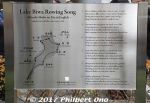
Monument's English side has a bilingual Lake Biwa map and Lake Biwa Rowing Song English lyrics.Directions: From JR Kyoto Station's Karasuma side (north side with Kyoto Tower), go to bus stop D2 and catch the No. 206 bus bound for "Gion Via Kiyomizu-dera Temple/Kitaoji Station" (三十三間堂・清水寺・祇園・百万遍). The bus leaves every 15 min. or so (bus schedule here), but it can be very crowded. The ride takes abut 30 min. Get off at "Kyodai Seimon-mae" (京大正門前). Cross the big road (Higashi-Oji-dori) and walk along Higashi-Ichijo street. The main Yoshida Campus will be on the left while the Yoshida-Minami Campus will be on the right. Enter the Yoshida-Minami Campus and walk to the central courtyard area.
(From Kyoto Station, there is also an express bus (京大快速) to Kyoto University Hospital from bus stop D3, but it runs only at certain times on weekdays, mainly in the morning and mid-afternoon (bus schedule here).
|
|

About the song and rowing route... この歌について(日本語解説)Shiga Prefecture's most famous and beloved song is called Biwako Shuko no Uta (琵琶湖周航の歌) or "Lake Biwa Rowing Song." I have rendered this song into both pictures and English, according to my own imagination and interpretation.
Please see this page for a full explanation: https://photoguide.jp/txt/Lake_Biwa_Rowing_Song
First composed in 1917 by a bunch of college students from Kyoto, the song has been recorded by many famous Japanese singers and groups. In 1971, it became a major nationwide hit with singer Tokiko Kato's rendition. Today, the song remains a favorite among choir groups in Japan, and a choir singing contest is held for the song every June (since 1997) in Imazu, the birthplace of the song in the northwestern corner of Lake Biwa.
Shiga Prefecture also has stone monuments dedicated to each of the six verses. There's even a museum (Biwako Shuko no Uta Shiryokan) in Imazu dedicated to the song. Okaya city on the shores of Lake Suwa in Nagano Prefecture, the birthplace of the song's composer, Taro Oguchi (小口太郎) (1897-1924), also has a song monument and bronze statue of him.
|
|

Otsu Exhibition, Nov. 21 - Dec. 4, 2005 at Shiga Kaikan, Otsu, Shiga. Right across from the Shiga Prefectural Office. 滋賀会館For this exhibition, I created my own photographic rendition of the places and scenes mentioned in the song and also photographed all the stone monuments dedicated to the song. I used Photoshop to composite images and to alter the colors into a dreamy condition as the song suggests. I also translated the lyrics into English.
The exhibition was held at Shiga Kaikan, right across from the Shiga Prefectural Office. Shiga Kaikan has two spaces for exhibitions, and I used the smaller space called Bunka Salon Gallery.
Map: http://www.shiga-bunshin.or.jp/shigakaikan/map.html
Address: Kyomachi 3-4-22, Otsu, Shiga Pref.
Phone: 077-525-9995
〒520-0044 大津市京町三丁目 4-22
Web site: http://www.shiga-bunshin.or.jp/shigakaikan/
|
|

Verse 1 Song Monument, Otsu (Mihogasaki). In 1973, this was the first monument built for the song. The song's first and most famous line, "Ware wa Umi no Ko" is written. 一番の歌碑。大津市三保ケ崎。This monument is near the boat house in Mihogasaki, a stone's throw from Hama-Otsu.
われは湖の子 さすらいの
旅にしあれば しみじみと
のぼる狭霧や さざなみの
志賀の都よ いざさらば
Ware wa Umi no Ko, sasurai no
tabi ni shiareba, shimijimi to
Noboru sagiri ya, sazanami no
Shiga no Miyako yo, iza saraba
|
|

On June 16, 2007, Imazu marked the 90th anniversary of the song by organizing a boat cruise on Lake Biwa and other events. Omi-Imazu Station had a sign directing guests to Imazu Port. 90周年の記念「琵琶湖周航クルーズ」の近江今津駅内
|
|

Front of Yoshida Chiaki's home in Niigata (formerly Niitsu) which I visited in Nov. 2007. Yoshida Chiaki composed a song called "Hitsuji-gusa" (Water Lilies) whose melody was used for the song "Biwako Shuko no Uta" (Lake Biwa Rowi
|
|

Imazu Port. A large crowd of people waiting to board the chartered boat for a 3-hour cruise on Lake Biwa to commemorate the 90th anniversary of the song, Biwako Shuko no Uta.
|
|
|

The photo above shows part of the stone monument for the first verse of the song. It reads "Ware wa Umi no Ko" (We're children of the lake). [url=http://photoguide.jp/txt/Lake_Biwa_Rowing_Song]More info about Lake Biwa Rowing Song here.[/uThis is the song's first and most famous line. The monument is in a small park near the former boathouse in Mihogasaki pier. The photo has been digitally altered (the colors are not real).
I visited and photographed all the places mentioned in the song as well as all the song monuments in Otsu, Omi-Maiko, Imazu, Chikubushima, Hikone, Chomeiji, and Okaya (Nagano). I also created some digital images to match the scenes mentioned in the song.
|
|
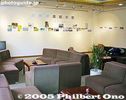
Title: Lake Biwa Rowing Song - In Pictures and in English Bunka Salon Gallery (also a coffee shop) inside Shiga Kaikan. 「琵琶湖周航の歌」〜写真と英語に〜The title was "Lake Biwa Boating Song - In Pictures and in English." I later changed the song title to "Lake Biwa Rowing Song."
Shiga Kaikan has two spaces for exhibitions, and I used the smaller space called Bunka Salon Gallery.
One entire wall and half of another wall were available for exhibitions free of charge.
|
|

The "Rio Grande" cruise boat awaits at Imazu Port on a miraculously sunny day during the rainy season. 梅雨でありながら、奇跡的にこんないい天気になった。今津港
|
|

Front gate of Yoshida Chiaki's home
|
|

My first and very small exhibition to introduce "Lake Biwa Rowing Song" in English. The English lyrics were still unfinished, so only an English translation was presented.I showed three images per verse (6 verses total), plus caption sheets and artist's message, boating map, and composer's biography on the other wall.
All the pictures were printed on A4 inkjet paper. Very low budget exhibition, but it caught the interest of one newspaper reporter. I later changed the song title to "Lake Biwa Rowing Song."
Exhibition Date & Time: Nov. 21 to Dec. 4, 2005, 9:30 am to 5:00 pm, closed Mon.
Map: http://www.shiga-bunshin.or.jp/shigakaikan/map.html
Address: Kyomachi 3-4-22, Otsu, Shiga Pref.
Phone: 077-525-9995
〒520-0044 大津市京町三丁目 4-22
Web site: http://www.shiga-bunshin.or.jp/shigakaikan/
|
|

Reception desk for passengers. A little over 100 people joined the cruise. クルーズの受付
|
|

Inner garden. I met Yoshida Yuki (吉田ゆき), the niece of Yoshida Chiaki who showed me the house and a few materials. Flowers planted by Chiaki still grow in the garden.
|
|

For each verse (total 6 verses), I showed three photos and a caption sheet with my non-singable English translation of the verse.「琵琶湖周航の歌」をイメージ写真付きで英訳された作詞と英文説明で紹介する写真展です。歌に登場する各地の写真や6番まですべての歌碑も英語で紹介。外国人も知って欲しい名曲です。英語の勉強にも!
2005年11月21日(月)〜12月4日(日) 9:30〜17:00
滋賀県大津市 滋賀会館 文化サロンギャラリー 入場無料
〒520-0044 大津市京町三丁目 4-22
Tel: 077-525-9995
HP: http://www.shiga-bunshin.or.jp/shigakaikan/
アクセス:
JR大津駅びわ湖口(北口)から徒歩5分
京阪浜大津駅からバス7分
名神大津インターからバス5分
京阪島ノ関駅から徒歩3分
1971年に加藤登紀子の大ヒットになったこの「琵琶湖周航の歌」は、昨年までに僕は聞いたことない。昨年の春に長野県諏訪市の御柱祭りを見に行ったときに岡谷市に泊まって近くの諏訪湖で散歩すると歌の作詞家である小口太郎(岡谷出身)の銅像があって「琵琶湖周航の歌」が紹介されて非常に興味深いものと思った。
英語で紹介したいなと思ってこの歌の英語版とイメージ写真をやっと完成しました。そしていつかこの歌を英語で歌ってもらいたい。歌詞を英語にすることはあまり難しくないが、それを歌のメロディに合わせることが大変。まだそこまで完成していない。もっと時間が必要。できあがったら、勿論また発表します。
この文化サロンは、サロン形の喫茶店になっている。
|
|

"Umi no Ko" (Child of the Lake) Lake Biwa training boatThe bow of Shiga Prefecture's "floating school." The name of this boat was obviously taken from the song. The boat is owned by Shiga Prefecture and used to educate elementary school kids about the lake. Since 1983, this ship has been serving as a floating school for kids where they stay overnight and spend two days conducting experiments to learn more about the lake. Picture was taken at Hikone Port.
|
|

Back of Verse 1 Song Monument, Otsu (Mihogasaki)Directions: From JR Otsu Station, take a bus to Mihogasaki. It's about 10 min. Or you can easily walk it from Hama-Otsu Station. Just walk on the main road toward the race boat arena. There will be a small marina on the right. Right after passing the marina, turn right into the small road. There will be a small park on the right. The monument is there. There are two stone monuments. It might be roped off and you're not supposed to enter the park. While you're there, walk around the marina and see the boathouse with the cherry blossom logo with three stripes. That's the logo of the school and the place where the boys left for the rowing trip in 1917. Otsu Station also has a tourist information office where you can obtain directions and a map.
|
|

Boarding time at Imazu Port. In the forefront is a song monument for Biwako Shuko no Uta.
|
|

Yoshida Chiaki's room on the 2nd floor.
|
|

Verse 1 photos (Otsu)
|
|

Megan and Jamie Thompson about to board the boat. トンプソン姉妹
|
|

Yoshida Chiaki's room on the 2nd floor. This is where he spent his final days while stricken with tuberculosis.
|
|

Verse 2 photos (Omi-Maiko)
|
|

"Umi no Ko" (Child of the Lake) Lake Biwa training boat for kids
|
|

Near the Verse 1 Song Monument is another stone monument engraved with the words of the entire song.
|
|

Boat name "Rio Grande" operated by Biwako Kisen. Named after Shiga's sister state in Brazil. There is also the "Michigan" paddlewheel boat named after Shiga's sister state in the USA.
|
|

View from Yoshida Chiaki's room on the 2nd floor. Sometimes they receive local school children for tours of the house.
|
|

Verse 3 photos (Imazu)
|
|

Inside the front of the Rio Grande boat. 琵琶湖周航クルージング
|
|

Stairs from Yoshida Chiaki's room on the 2nd floor.
|
|

Verse 4 photos (Chikubushima)
|
|

Small park where the Verse 1 monument is located.This monument is near the boat house in Mihogasaki, a stone's throw from Hama-Otsu. It was built in 1973 as the first monument for the song.
This little park is actually off-limits and you're not supposed to enter it, for some reason. On the left side of the picture is another stone monument hidden by brush. It is engraved with the entire song. In the background, you can see the roof of the boathouse.
|
|

Open deck at the rear. The boat departed at about 11:30 am.
|
|

Original copy of the magazine "Ongaku-kai" (The Musical Japan) where Yoshida Chiaki's song "Hitsuji-gusa" was first published and made popular. Issued in Aug. 1915. 音楽界
|
|

Verse 5 photos (Hikone)
|
|

We passed by various scenic spots such as Shirahige Shrine, noted for the torii gate in the lake.
|
|

Table of Contents of magazine "Ongaku-kai" (The Musical Japan) 音楽界. Many music-related articles.
|
|

Verse 6 photos (Chomeiji)
|
|

Shirahige Shrine 白髭神社
|
|

On the first page is Yoshida Chiaki's song "Hitsuji-gusa" (Water Lilies) which was acclaimed enough to be published here.
|
|

On the adjacent wall, I showed a map of the rowing route, artist's message in English and Japanese, and an English biography of Taro Oguchi, the songwriter.
|
|
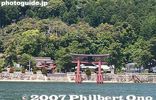
Shirahige Shrine torii as seen from the cruise boat.
|
|

On the first page is Yoshida Chiaki's song "Hitsuji-gusa" (Water Lilies). Although the melody is different, the lyrics are a direct translation of a childen's song called Water Lilies written by E.R.B. in the UK.
|
|

Omi-Maiko with green pines on white sands. 近江舞子の「松は緑に 砂白き」
|
|

Small book titled "A Garland of Flower-Poems" published in Japan. This was owned by Yoshida Chiaki and it includes the UK song "Water Lilies."
|
|

Omi-Maiko appears in the song.
|
|

Page where "Water Lilies" is printed in the book. It is very likely that Chiaki found the song in this book, and decided to make his Japanese version. His signature is on the back of the book.
|
|

Rolling with the waves
|
|
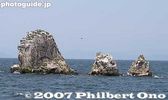
Okino-shiraishi Rocks, a favorite resting place for birds which turned the rocks white from bird droppings. Four rocks stand 80 meters deep in the lake. Out of the water, the tallest stands 14 meters high. 沖の白石
|
|

So what does "Coral shrine" mean in the song? (There's no coral in the lake.) "I think it just refers to a beautiful place..." 「珊瑚の宮」はどういう意味?
|
|

We landed on Chikubushima for about an hour. Jamie and Megan also sang in English in front of the Verse 4 song monument.
|
|

Jamie and Megan Thompson sing in English in front of the Verse 4 song monument, Chikubushima. Next time we need to have an amplifier.
|
|

Jamie and Megan Thompson sing in English in front of the Verse 4 song monument, Chikubushima. They sang up to Verse 4. ジェイミーとメゲン・トンプソン姉妹が歌う
|
|

Verse 2 Song Monument, Omi-Maiko (Omatsu). On the lake shore in Omi-Maiko (Omatsu) behind Hotel Biwa Lake Otsuka. Built in March 1989. 二番の歌碑。近江舞子(ホテル琵琶レイクオーツカの前)Pine trees are very green, on sands very white.
Omatsugasato is, a young maiden's home.
Bush of red camellia, hides her teary face.
She's weeping o'er a lost love, much too short to last.
Matsu wa midori ni, suna shiroki
Omatsugasato no, otomego wa
Akai tsubaki no, morikage ni
Hakanai koi ni, naku toka ya
松は緑に 砂白き
雄松が里の 乙女子は
赤い椿の 森蔭に
|
|

YouTube video of the song Hitsuji-gusa (Water Lilies) by a choir called Koai Gassho no Kai (小合合唱の会) performing at a memorial gathering on the anniversary of Chiaki’s death in Feb. 2013 at Chiaki’s birth home.Video uploaded by Ichii Yasuzo in Niigata.
|
|

Mihogasaki harbor, Otsu. The arrow points to the boat house where Oguchi Taro and crew departed for their rowing trips.Mihogasaki is accessible by bus from Otsu Station. Or just walk west from Hama-Otsu. This is also where water from the lake is drawn into the Biwako Canal's first canal which feeds water to Kyoto.
|
|

Old photo of Verse 2 Song Monument in Omi-Maiko. The tree was cut down and lyrics later painted white.
|
|

The man holds the 90th Anniversary tour sign as a guide for the tour guests.
|
|

Imazu Exhibition, May 16 - June 25, 2006 at Biwako Shuko no Uta Shiryokan, Takashima, Shiga. Photo exhibition poster.
|
|

Getting back on the boat. Little over a hundred people came on this cruise. If people knew it was gonna be such a beautiful day during this rainy season, more would have certainly come.
|
|
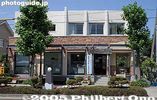
Biwako Shuko no Uta Shiryokan song museum, in Imazu, Shiga 琵琶湖周航の歌資料館
|
|

Verse 2 monument is on the lake shore, in front of Hotel Biwa Lake Otsuka, near what appears to be a boat pier. Short walk from Omi-Maiko Station.Directions: Near Omi-Maiko Station on the JR Kosei Line. After exiting the station, walk left toward Kitahama. Then get to the lake shore and walk along the lakeshore road until you see the monument under a large tree right on the shore. It is in front of Hotel Biwa Lake Otsuka.
|
|

Mihogasaki harbor, Otsu. The arrow points to the boat house.
|
|

Sachiko Tsuji, the MC, interviews the sisters before they sang on the boat. 自動販売機前でインタービュー。船内の客は姉妹の顔や姿がほとんど見えへん。
|
|

Title: Lake Biwa Rowing Song - In Pictures and in English 「琵琶湖周航の歌」写真と英語に. Entrance to exhibition room in the song museum, Imazu.
|
|

Jamie and Megan Thompson sing in English while cruising on Lake Biwa. 船の真ん中で歌って自動販売機がバックになって最悪。客に背中を向くばかりで申し訳ない。船の一番前に歌いたいと頼んだけど...
|
|

Across the road from the Verse 2 song monument is this small music box. Press the button and you can hear the song play (sung by Kato Tokiko).
|
|

Exhibition room on the 2nd floor of the Biwako Shuko no Uta Shiryokan song museum.
|
|

Boat house where Taro Oguchi and crew departed on their rowing trip. No longer used by the university's boat club. Mihogasaki, Otsu
|
|

After they sang, there was a mad rush to buy the CD priced at 800 yen. 英語版CDの購入者が殺到。
|
|
|

Then they signed autographs on the CD. CDのサインを求める。
|
|

Verse 1 Lyrics (Otsu) 一番の英訳(大津). School logo on boat house, a cherry blossom with three stripes for Dai-san Koto Gakko.We're children of the lake, off to wander 'round.
This journey fills my heart with, intense happiness.
Rising mist evaporates, ripples come and go.
Shiga's Miyako dear, bid farewell for now.
われは湖の子 さすらいの
旅にしあれば しみじみと
のぼる狭霧や さざなみの
志賀の都よ いざさらば
Ware wa Umi no Ko, sasurai no
tabi ni shiareba, shimijimi to
Noboru sagiri ya, sazanami no
Shiga no Miyako yo, iza saraba
--
This first verse refers to the start of the journey of life. The lake mist symbolizes the uncertainty of what lies ahead.
The capital of Shiga is Otsu, where they departed from Mihogasaki boat harbor on June 27, 1917. For some reason, the kanji characters for "Shiga" is incorrect for Shiga Prefecture.
|
|

More autographs. 姉妹はやはり人気者。
|
|

Crowd gathers
|
|
|

Exhibition introduction
|
|

Verse 6 song monument photos (Chomeiji)
|
|
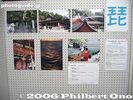
Verse 6 photos (Chomeiji)
|
|

"Rising mist evaporates, ripples come and go." のぼる狭霧や さざなみの
|
|

Water lilies. The melody of the song originally came from a song called "Hitsuji-gusa" which means water lilies.
|
|
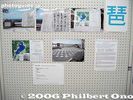
Verse 5 song monument photos (Hikone)
|
|

Water lily (Hitsuji-gusa). ひつじぐさ
|
|
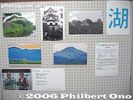
Verse 5 photos (Hikone)
|
|

Reeds bid rowers farewell for now...
|
|

After the boat cruise, there was a walking tour of Imazu. A special exhibition was held at the local community center in Imazu. 「周航の物語展」今津東コミセン
|
|
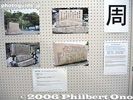
Verse 4 song monument photos (Chikubushima)
|
|

「周航の物語展」今津東コミセン
|
|
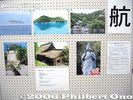
Verse 4 photos (Chikubushima)
|
|

Rear of boat house, now used by a private boat club.
|
|

This showcase showed things from the old Daisan Koto Gakko college.
|
|
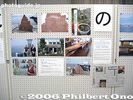
Verse 3 song monument photos (Imazu)
|
|

Student uniform for Daisan Koto Gakko school.
|
|
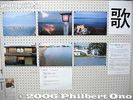
Verse 3 photos (Imazu)
|
|

Daisan Koto Gakko Rowing club towel
|
|
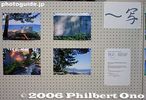
Verse 2 song monument photos (Omi-Maiko)
|
|

Daisan Koto Gakko book of songs
|
|

Verse 2 photos (Omi-Maiko)
|
|

Chojiya ryokan along the lake shore. Likely this is where Oguchi Taro and crew stayed. 丁子屋という旅館
|
|

Verse 1 song monument photos (Otsu)
|
|

Inside Chojiya. Very impressive Japanese-style inn with lake views.
|
|

Verse 1 photos (Otsu)
|
|

Room in Chojiya ryokan.
|
|
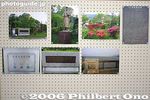
Photos of the song monument and Taro Oguchi statue in Okaya, Nagano, his hometown.
|
|

Inside Chojiya. The inn is famous for serving duck.
|
|

Another local landmark was this former bank building designed by William Merrell Vories who designed many buildings in Shiga, especially in Omi-Hachiman.
|
|

Verse 3 Song Monument, Imazu. A lantern, at the end of the pier at Imazu Port. 三番の歌碑。今津港の桟橋。夜に赤く点灯。This is at the end of Imazu Pier. At night, this lamp lights up in red. You can see Chikubushima island and Mt. Ibuki in the background.
|
|

Inside former bank building.
|
|

Verse 3 Song Monument
|
|

In the evening during 5 pm-6:30pm, a slide show lecture about Oguchi Taro and Yoshida Chiaki was given by Iida Tadayoshi, a song researcher. Held at a hotel in Imazu. 歌と映像でつづる「小口太郎と吉田千秋の物語」講演会
|
|

German-made accordian used by Yoshida Chiaki was also on display.
|
|

View of Imazu shore from hotel
|
|

A reception was held afterward in the hotel. The mayor of Takashima, Hidekazu Kaito, speaks. I gave him a copy of our CD. 高島市長 海東英和
|
|

Verse 3 Song Monument is written with Verse 3.We drift from wave to wave, straying aimlessly.
On shore we see red fire, brings back memories.
With our sights set nowhere, rolling with the waves.
Today is Imazu or, Nagahama huh.
Nami no mani mani, tadayoeba
Akai tomaribi, natsukashimi
Yukue sadamenu, nami makura
Kyo wa Imazu ka, Nagahama ka
浪のまにまに 漂えば
赤い泊火 懐かしみ
行方定めぬ 浪枕
今日は今津か 長浜か
|
|

Interestingly, the mayor's first name "Hidekazu" means "English-Japanese." The next day, at the choir contest, he told us that he listened to and liked our song.
|
|

Imazu Port. Verse 3 Song Monument is at the end of the dock. The same dock used by boats going to Chikubushima. The dock is usually closed.Chikubushima island and Mt. Ibuki can be seen.
|
|

Kanpai!
|
|

Meeting Iida Tadayoshi, song researcher and former NHK announcer.
|
|

In the end, we all sang the song, including the mayor of Takashima.
|
|

Verse 2 Lyrics (Omatsu/Omi-Maiko) 二番の英訳(雄松"Pine trees are very green, on sands very white.
Omatsugasato is, a young maiden's home.
Bush of red camellia, hides her teary face.
She's weeping o'er a lost love, much too short to last.
松は緑に 砂白き
雄松が里の 乙女子は
赤い椿の 森蔭に
はかない恋に 泣くとかや
Matsu wa midori ni, suna shiroki
Omatsugasato no, otomego wa
Akai tsubaki no, morikage ni
Hakanai koi ni, naku toka ya
Omi-Maiko is still famous for white sand beaches and pine trees. In summer these beaches are cluttered with people trying to get a tan.
See more photos of Omi-Maiko here.
|
|

最後に皆で周航歌を歌う。
|
|

Nagahama Exhibition, July 1 - Aug. 10, 2006 at Biwa Library, Nagahama, Shiga Prefecture. Exhibition poster.
|
|

Lute Plaza, which includes Biwa Library in Nagahama, Shiga. 20-min. bus ride from Nagahama Station.
|
|
|
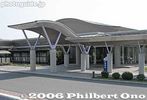
Biwa Library びわ図書館
|
|

"Pine trees are very green, on sands very white." Omi-Maiko
|
|

Title: Lake Biwa Rowing Song - Sing in English! 「琵琶湖周航の歌」英語で歌おう! Entrance to Biwa Library.
|
|

White sands of Omi-Maiko (Omatsu), Otsu, Shiga
|
|

Photo exhibition in Biwa Library, Nagahama, Shiga Pref.
|
|

Photo exhibition in Biwa Library
|
|

Ripples lap white sands of Omi-Maiko.
|
|

Photo exhibition panels at Biwa Library
|
|

Photo exhibition panels
|
|

Pine trees at Omi-Maiko
|
|

Photo exhibition panels at Biwa Library
|
|
|
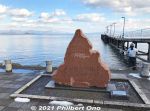
Biwako Shuko no Uta Birthplace Monument, Imazu. This is Imazu's second monument for the song. 全歌詞碑の「琵琶湖周航の歌」誕生の地 今津。今津港。背景には竹生島行きの船。Imazu has two monuments for the song. The first one is a lamp at the end of the pier (visible in this picture on the right of the boat). That was for Verse 3 which is written on the lamp post.
Later in 1994, Imazu town built this red clay monument to commemorate the song's birth in Imazu. The entire lyrics is also engraved. It is next to the Imazu boat pier where boats depart for Chikubushima. Looks like a red flame, but it's shaped after the geographical shape of Imazu town.
|
|

The photos displayed were almost the same as the Imazu exhibition.
|
|
|

Kyoto University Rowing Club arrive at Omi-Maiko in Aug. 2006 during their annual Lake Biwa rowing trip.
|
|
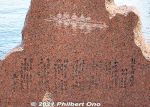
The monument is engraved with the entire song and a picture of rowers.
|
|

Omatsu "Famous Place" marker
|
|

Omatsukan ryokan at Omi-Maiko. This is where Oguchi Taro and rowing mates stayed when they rowed around Lake Biwa. 雄松館
|
|
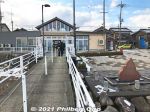
Imazu Port. The song monument is on the right. Looks like a "red fire" as mentioned in the song.From Imazu Port, you can easily go to Chikubushima island by boat, from where you can take another boat to Hikone or Nagahama. Going vice versa is possible too. It's a great way to traverse the lake.
See more photos of Imazu here.
|
|

Song Monument, Imazu. Looks like red fire, but it's also the shape of Imazu town. (The background shows the old Imazu Port building.)Directions: From Omi-Imazu Station on the JR Kosei Line, get out the east exit and walk on the main road toward the lake. You will soon see the Biwako Shuko no Uta Shiryokan song museum on the left. Be sure to visit this museum too. Walk further toward the lake and you will see Imazu Port. Near the water, you can see the "red fire" song monument. On the very end of the pier, and you can see the lamp monument. (The pier might be closed off if there is no boat, so you may have to ask permission to walk on the pier.) Omi-Imazu Station also has a tourist information office where you can obtain directions and a map.
|
|

Song monument at Imazu Port.
|
|
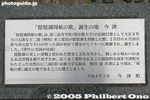
Song Monument plaque, Imazu. It explains about how the song was created in Imazu.
|
|
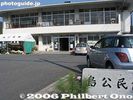
Omi-Hachiman One-Day Exhibition, Oct. 29, 2006 at Shima Kominkan Public Hall, Omi-Hachiman, Shiga. 島公民館文化祭
|
|
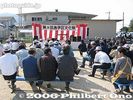
Opening ceremony for the Culture Festival (Bunka-sai) at this public hall near Chomeiji temple in Omi-Hachiman.
|
|

Imazu Port and song monument in winter snow.
|
|

Entrance to my photo exhibition in Shima Kominkan Public Hall during their day-long Bunka-sai Culture Festival.
|
|
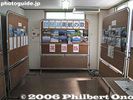
Title: Lake Biwa Rowing Song in English 「琵琶湖周航の歌」英語版
|
|

Chikubushima island and snowly Mt. Ibuki in the background.
|
|

Center exhibition panel with song location images
|
|
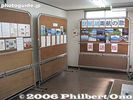
Two panels on left wall
|
|
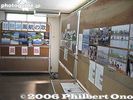
Two panels on right wall
|
|
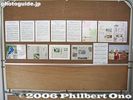
Introduction to the song and newspaper articles
|
|
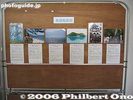
Explanation of English lyrics for the six verses.
|
|
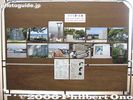
Photos of song monuments.
|
|
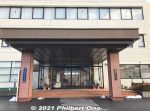
Biwako Shuko no Uta Shiryokan (Lake Biwa Rowing Song Museum) moved to this building's 1st floor and opened on April 1, 2020. This is the Imazu-Higashi Community Center (今津東コミュニティセンター).Right across from the Imazu Shimin Kaikan concert hall.
|
|
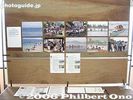
Photos of Kyoto University Rowing Club's Lake Biwa rowing trip, including a picture of them posing with the Chomeiji song monument.
|
|
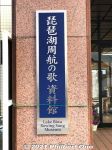
The museum sign includes English! Official English name is "Lake Biwa Rowing Song Museum." 琵琶湖周航の歌資料館
|
|
|

Entrance to the new Biwako Shuko no Uta Shiryokan (Lake Biwa Rowing Song Museum) in Imazu. 琵琶湖周航の歌資料館
|
|

"On shore, we see red fire"Imazu was where the song was born. The town has two monuments for the song. One is the lamp monument built in 1985 on the boat pier (top photo) for Verse 3 (written on the lamp post), and the other is a red stone monument in the shape of a fire dedicated to the entire song. The lamp monument lights up in red at night. The above image was digitally altered.
|
|
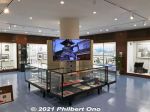
The museum has various panel exhibits, videos, etc. Currently, no explanations in English. Tokiko Kato scored a national hit with the song in 1971.
|
|
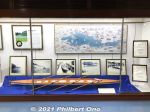
Model of fixed-seat boat used during Oguchi Taro's time in 1917.
|
|

"On shore we see red fire, brings back memories." (Imazu)This is the lake beach at Imazu.
See more photos of Imazu here.
|
|
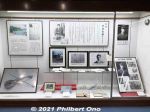
Exhibit for Oguchi Taro who composed the song.
|
|
|

Lake shore at Imazu
|
|
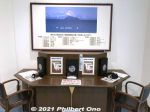
CD listening station for many cover versions by famous Japanese singers and groups. There are many, and you can listen to each of them.The song was included in a record for the first time in 1958 when Kyoto University made an album of its university songs on the 90th anniversary of the school's founding. In 1961, a chorus group named Boney Jacks recorded the song in an album of Japanese songs. And so did singer Peggy Hayama in 1962.
|
|

Peninsula where Oguchi Taro and crew departed Imazu. On this peninsula at Imazu, Taro Oguchi and crew departed in their boat for Chikubushima island. The large building is a boathouse that stores two reconstructed fixed-seat boats.
|
|

The large boat house houses two reconstructed fixed-seat boats. This is where Oguchi and crew departed Imazu for Chikubushima.
|
|

Okaya One-Day Exhibition, Mar. 4, 2007 at Canora Hall, Okaya, Nagano.
|
|

Title: Lake Biwa Rowing Song in English 「琵琶湖周航の歌」英語版
|
|
|
|

My photo exhibition with two panels showing photos of places mentioned in the song and song monuments.
|
|

Left panel.
|
|

Right panel.
|
|

Below the photos were explanation of the song and English lyrics.
|
|

Some English explanations also provided.
|
|

Yokaichi Exhibition, May 9-27, 2007 at Yokaichi Public Library, HigashiOmi, Shiga. Photo exhibition poster.
|
|
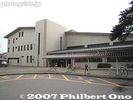
Yokaichi Public Library, near Yokaichi Station. 東近江市 八日市図書館
|
|

2nd floor gallery in Yokaichi Public Library. This floor is also like a coffee shop.
|
|

Lake waters of Imazu, with Chikubushima and Mt. Ibuki in the distance.
|
|

First panel explaining Verses 1 and 2, Yokaichi Public Library 2nd floor gallery
|
|

Second panel explaining Verses 3 and 4.
|
|

Nagahama Castle as seen from Lake Biwa. More photos of Nagahama here.The castle tower was reconstructed in 1984.
More photos of Nagahama here.
|
|

Third panel explaining Verses 5 and 6.
|
|

Fourth panel showing all the song monuments in Shiga and Okaya, Nagano.
|
|
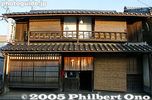
Chojiya ryokan inn, Imazu. This is probably the inn where Taro Oguchi and crew stayed in Imazu and created the song in 1917. 丁子屋It is along the lake shore and still in business today.
It was on June 28, 1917 in Imazu, after dinner on the second day of their rowing trip, when a boatmate named Jiro Nakayasu exclaimed, "Hey everyone, listen up! Oguchi has written this song," and showed everyone the song. Then another boatmate named Taniguchi, who knew a popular song called Hitsuji Kusa (Water Lilies), began singing Oguchi's lyrics to the melody. Since the melody went well with the words, the seven boat crewmates sang the song together that night. It was the birth of the Lake Biwa Rowing Song. The boys worked on the song further and sang it while rowing.
See more photos of Imazu here.
|
|

Fifth and final panel showing photos of our song-related activities.
|
|

2nd Imazu Exhibition, May 30 - July 1, 2007 at Biwako Shuko no Uta Shiryokan, Takashima, Shiga. This was the second time to have an exhibition here. Photo exhibition poster.
|
|

Chikubushima as seen from Imazu
|
|

One half of the exhibition. It is similar to the exhibition held here a year before, but many new photos have been added. They include photos of the Kyoto Univ. Rowing Club and our activities in the past year.
|
|

1st panel explaining about the exhibition and English song. This exhibition coincides with the June 16, 2007 release of our Lake Biwa Rowing Song CD.
|
|

2nd panel showing Verse 1 (Otsu)
|
|

3rd panel showing Verse 2 (Omatsu or Omi-Maiko)
|
|

4th panel showing Verse 3 (Imazu)
|
|

5th panel showing Verse 4 (Chikubushima)
|
|

6th panel showing Verse 5 (Hikone)
|
|

7th panel showing Verse 6 (Chomeiji)
|
|

8th panel showing song monuments for Verses 1-3
|
|

9th panel showing song monuments for Verses 4-6
|
|

10th panel showing Oguchi Taro song monument and his grave and house in Okaya, Nagano.
|
|

11th panel showing photos of our song-related activities. Our first public performance, appearance on NHK Nodo Jiman, CD recording, etc.
|
|

12th panel showing photos of our song-related activities.
|
|

13th panel showing photos of Kyoto University Rowing Club rowing around Lake Biwa in Aug. 2006.
|
|
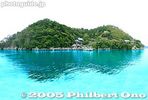
Verse 4 Lyrics (Chikubushima) 四番の英訳(竹生島)Azure blue flower garden, revered coral shrine.
Full of old-time stories, Chikubushima.
In the hands of Buddha, one young maiden lies.
She's sleeping in compassion, resting peacefully.
瑠璃の花園 珊瑚の宮
古い伝えの 竹生島
仏の御手に いだかれて
ねむれ乙女子 やすらけく
Ruri no hanazono, sango no miya
Furui tsutae no, Chikubujima
Hotoke no mite ni, idakarete
Nemure otomego, yasurakeku
Lake Biwa's most famous and sacred island is accessible by boat from Hikone, Nagahama, and Imazu. Color of the water in the photo is not real.
|
|

Last panel showing news articles and Web pages and people singing the song.
|
|

Maibara Exhibition, July 19 - Aug. 3, 2007 at Lucci Plaza, Maibara, Shiga. Near Omi-Nagaoka Station. Photo exhibition poster.
|
|
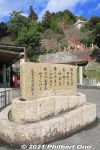
Verse 4 Song Monument, Chikubushima. Built in 1987 by Biwako Kisen, tour boat operator. 四番の歌碑。竹生島の桟橋のすぐそば。琵琶湖汽船が寄贈。The monument is right near the island's boat pier.
See more photos of Chikubushima here.
|
|

"Full of old-time stories, Chikubushima."The island has a complex of temples named Hogonji. It belongs to the Shingon Buddhist Sect (Buzan School). It is said that it was first built in 724. It is also the 30th temple in the 33 Temple Pilgrimage of Saigoku (Western Japan).
See more photos of Chikubushima here.
|
|

Eight exhibition panels in the spacious lobby.
|
|
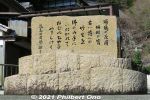
Verse 4 Song Monument, ChikubushimaAzure blue flower garden, revered coral shrine.
Full of old-time stories, Chikubushima.
In the hands of Buddha, one young maiden lies.
She's sleeping in compassion, resting peacefully.
Ruri no hanazono, sango no miya
Furui tsutae no, Chikubujima
Hotoke no mite ni, idakarete
Nemure otomego, yasurakeku
瑠璃の花園 珊瑚の宮
古い伝えの 竹生島
仏の御手に いだかれて
ねむれ乙女子 やすらけく
|
|

"Azure blue flower garden, revered coral shrine."
|
|

1st panel for Verse 1 and explanation about the exhibition and English song.
|
|

2nd panel showing Verse 2 (Omatsu or Omi-Maiko)
|
|
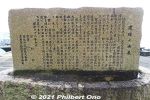
Rear of Verse 4 Song Monument, Chikubushima.It explains about the origin of the song. The monument was donated by the Biwako Kisen tour boat company which operates the boats going to the island as well as other tour boats in Lake Biwa, including the Michigan paddlewheel boat based in Otsu.
|
|

Broken dishes near the torii
|
|

3rd panel showing Verse 3 (Imazu)
|
|

"Full of old-time stories, Chikubushima." Karamon Gate, National Treasure
|
|

Chikubushima boat dock. The Verse 4 Song Monument on can be seen on the left.
|
|

5th panel showing Verse 4 (Chikubushima)
|
|

Karamon Gate, National Treasure. Renovated in March 2020.
|
|

5th panel showing Verse 5 (Hikone)
|
|

6th panel showing Verse 6 (Chomeiji)
|
|

Verse 3 Song Monument, Nagahama. Built and unveiled on June 25, 2017 by a non-profit citizens group in Nagahama formed to build this new song monument for the song's 100th anniversary. 三番の歌碑。長浜城のそば�The new Verse 3 Song Monument is near Nagahama Castle near the lake shore. It was unveiled with great fanfare by singer Kato Tokiko and others.
|
|
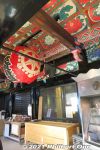
Kannon-do Hall, Hogonji Temple.
|
|

Buddha statue on Chikubushima
|
|

7th panel showing photos of our song-related activities. Our first public performance, appearance on NHK Nodo Jiman, CD recording, etc. Also newspaper articles.
|
|
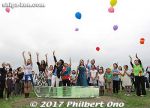
The song monument is made of glass and functions as a park bench for four people. Glassware is one of Nagahama's signature products. Verse 3 is engraved in the middle. It reportedly cost several million yen.After the unveiling, local singers sang the song with Kato Tokiko before everyone released balloons.
|
|
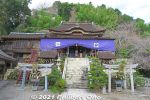
Tsukubusuma Shrine (National Treasure), Chikubushima 都久夫須麻神社
|
|

8th panel showing more newspaper articles, and guest book messages.
|
|

The first people to sit on the song monument. L-R: Nagahama-native Kitagawa Akihiro of the duo ~Lefa~, singer and special guest Kato Tokiko, Kada Yukiko former Shiga governor, and the mayor of Nagahama.
|
|
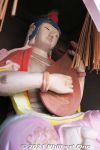
Benzaiten Goddess with her biwa lute.
|
|

Exhibition title even on the rear side of the exhibition panels.
|
|

On June 26, 2017, alumni of the Kyoto University Rowing Club rowed around Lake Biwa and took a break at Nagahama where they sang in front of the new song monument.
|
|

Benzaiten-do Hall, Hogonji Temple's Hondo main hall.
|
|

Shiga JET Art Show, March 20-23, 2008 at Biwako Bunkakan, Otsu, Shiga. Shiga's JET teachers held an art show and I provided photos for Jamie Thompson, a Shiga JET.
|
|

Verse 3 Song Monument at Nagahama's Hokoen Park. It is shaped like a boat and the top has a wavy surface like the water. It is called the "nami-makura" (rolling waves) design.The glass bench is positioned for sunset views over the lake.
Update: Unfortunately, this glass bench monument cracked and was replaced with another bench monument in Sept. 2021.
|
|
|

Biwako Bunkakan is the lakeside building that looks like a castle. Used to be an aquarium before it was converted into an art museum. Now closed.
|
|

Verse 3 Song Monument in Nagahama's Hokoen Park near Nagahama Castle is engraved with Verse 3.浪のまにまに 漂えば
赤い泊火 懐かしみ
行方定めぬ 浪枕
今日は今津か 長浜か
Nami no mani mani, tadayoeba
Akai tomaribi, natsukashimi
Yukue sadamenu, nami makura
Kyo wa Imazu ka, Nagahama ka
|
|
|

The glass bench actually consists of several glass pieces. A few are largely transparent.
|
|
|
|
|